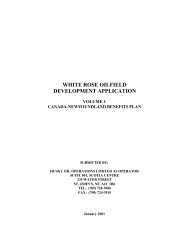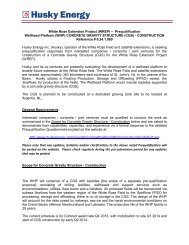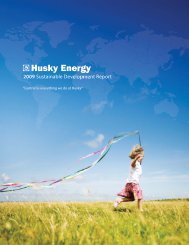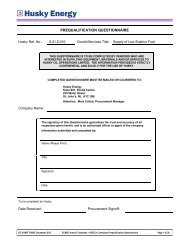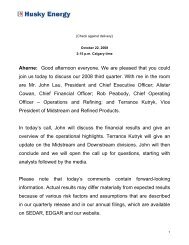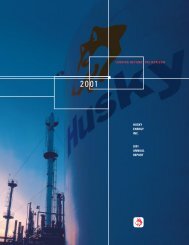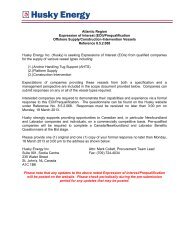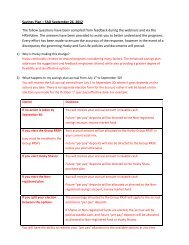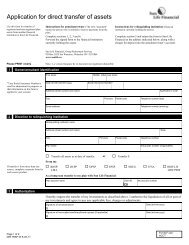white rose oilfield development application - Husky Energy
white rose oilfield development application - Husky Energy
white rose oilfield development application - Husky Energy
- No tags were found...
Create successful ePaper yourself
Turn your PDF publications into a flip-book with our unique Google optimized e-Paper software.
The effects of project <strong>development</strong>, production and decommissioning on sea turtles are expected to besimilar to those for marine mammals. Overall, the project will have an adverse, but not significant,effect on sea turtles during all project phases.The White Rose site will be abandoned and restored at the end of production to minimize effects on theenvironment. Although decommissioning activities may create some short term disturbance andnegligible effects within relatively short time periods, overall, a positive effect on marine mammals mayoccur as a result of stopping project activity.Whales are not considered at high risk to the effects of oil exposure, however, whales present in thestudy area could suffer sublethal effects through oiling of mucous membranes or the eyes if they swimthrough an oil-contaminated area. These effects are reversible and would not likely cause permanentdamage to the animals. There is a possibility that the baleen of whales could be contaminated with oil,thereby reducing filtration efficiency. However, effects would be minimal and reversible. Also, there islittle chance that oil will reach the southeast shoal of the Grand Banks where baleen whales, likehumpbacks, are known to concentrate to feed on capelin. Whales are present on the offshore portions ofthe Grand Banks in low numbers at certain times of the year. Therefore, only small proportions ofpopulations are at risk at any time.Likewise, seals are not considered at high risk to the effects of oil exposure, but some evidenceimplicates oil spills with seal, particularly young seal, mortality. The majority of seals present in thestudy area are associated with the edge of the pack ice. In average years, the ice edge extends no closerthan several hundred kilometres north of the White Rose area and then only for several months of theyear. The oil spill trajectory models indicate that after the oil moves away from a release point at WhiteRose, it will likely be found to the east and southeast of White Rose. Therefore, it is highly unlikely thatoil accidentally released at the White Rose site will reach the ice edge during years with average iceconditions. Few seals are expected to be exposed to oil from an accidental release at the White Rose siteand most seals do not exhibit large behavioural or physiological reactions to limited surface oiling,incidental exposure to contaminated food or ingestion of oil.Sea turtles are rare on the Grand Banks and particularly rare in the cold water of the White Rose area.Although there are no reliable data on sea turtle abundance and distribution on the Grand Banks, at-seaobserver data collected by the U.S. National Marine Fisheries Service (NMFS) for the pelagic longlinefishery provide some insight. During late summer to early fall, some sea turtles may occur on the GrandBanks. However, most sightings have occurred well west of the White Rose site. There is little chancethat sea turtles will be exposed to oil from an accidental release at White Rose. Effects of oil on seaturtles may be reversible, but there is a possibility that foraging abilities may be inhibited by exposure tooil.Depending on the time of year, location of marine mammals and turtles within the study area, and typeof oil spill or blowout, the effects of an offshore oil release could range from negligible to low.White Rose DA Project Summary • January 2001 Page 78



